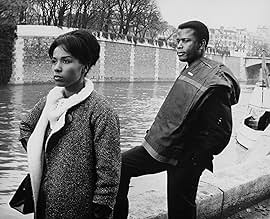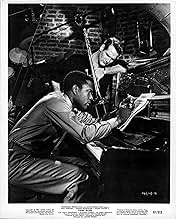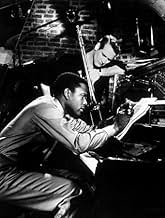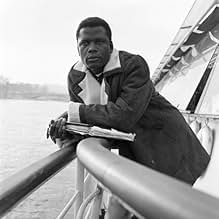IMDb रेटिंग
6.7/10
4.3 हज़ार
आपकी रेटिंग
अपनी भाषा में प्लॉट जोड़ेंDuring the 1960s, two American expatriate jazz musicians living in Paris meet and fall in love with two American tourist girls.During the 1960s, two American expatriate jazz musicians living in Paris meet and fall in love with two American tourist girls.During the 1960s, two American expatriate jazz musicians living in Paris meet and fall in love with two American tourist girls.
- 1 ऑस्कर के लिए नामांकित
- 2 कुल नामांकन
Guy Pedersen
- Bass Player
- (as Guy Pederson)
Emilien Antille
- Alto Sax Player with Armstrong at Club 33
- (बिना क्रेडिट के)
Roger Blin
- Guitarist Fausto the Moor
- (बिना क्रेडिट के)
Charles Bouillaud
- Luggage Carrier in Train
- (बिना क्रेडिट के)
Michel Dacquin
- Guest at Devigne's Party
- (बिना क्रेडिट के)
Hélène Dieudonné
- The Pusher
- (बिना क्रेडिट के)
Michel Garland
- Club 33 Customer
- (बिना क्रेडिट के)
फ़ीचर्ड समीक्षाएं
I read all the other comments regarding this movie, and especially the commentator from Toronto, who stated that the trite clichés of American movies abound in this one; then Green Card and French Kiss were mentioned (Yes, those films WERE awful); The music is excellent; Duke Ellington's music is the backdrop; and Louis Armstrong appears in the film. Sidney Poitier is always right on the mark, sensitive and real; a superb actor. Joanne Woodward and Paul Newman play the ill-fated couple; and do quite well, as has already been mentioned in several reviews. While the story itself is not original, the cinematography is; you will see the street markets; walking along the Seine, Montmartre, Notre Dame, etc. (Compare this to the last big Hollywood film "Moulin Rouge", and I would prefer this film any day!).
This film is to be appreciated for the era it depicts; I have traveled to Europe, and always find that each person's impression is different; Americans who have never traveled unfortunately perpetuate the stereotype; That is sheer ignorance, however. I sincerely hope that all Europeans do not see Americans as portrayed by Meg Ryan, an imbecilic blonde American; or for example, "Le Divorce", with Kate Hudson and Naomi Watts; Please note that Hollywood does NOT represent educated Americans. This is in itself sad, because in the 1960's, when my mother traveled to Europe, I think the world was more friendly; now when even the U.S. is divided into "red" and "blue" states; we are consigned to trash films like "Le Divorce", which Hollywood makes for the lowest common denominator, instead of smaller "art" films which are a pleasant experience.
It is a shame that Hollywood portrays Americans as uncultured imbeciles; this is all about the bottom line (profits). I can honestly say that a real person has not been portrayed by American film blockbusters since the 1970's.
See this film for yourself. It is definitely worth it.
This film is to be appreciated for the era it depicts; I have traveled to Europe, and always find that each person's impression is different; Americans who have never traveled unfortunately perpetuate the stereotype; That is sheer ignorance, however. I sincerely hope that all Europeans do not see Americans as portrayed by Meg Ryan, an imbecilic blonde American; or for example, "Le Divorce", with Kate Hudson and Naomi Watts; Please note that Hollywood does NOT represent educated Americans. This is in itself sad, because in the 1960's, when my mother traveled to Europe, I think the world was more friendly; now when even the U.S. is divided into "red" and "blue" states; we are consigned to trash films like "Le Divorce", which Hollywood makes for the lowest common denominator, instead of smaller "art" films which are a pleasant experience.
It is a shame that Hollywood portrays Americans as uncultured imbeciles; this is all about the bottom line (profits). I can honestly say that a real person has not been portrayed by American film blockbusters since the 1970's.
See this film for yourself. It is definitely worth it.
PARIS BLUES won't change your life unless you were one of those people (and I count myself one of them) that has been teetering on the verge of Euro-philia and this is the final straw to make you sell off all that crap you've acumulated over the years and live like a peddler just to be in Paris. Even if you are not, this movie could make you think twice. The core of the film is basically by-rote romances that, in themselves, would be non-descipt except for the fact that nothing Paul Newman touches can be bland. It is the elements surrounding these two romances that makes the film worth watching. Generally, to be a watchable film, the sum of the parts have to add up to more than the whole. Here, the film is simply the sum of it's parts...and those parts are wonderful. If I was to tell somebody there was a film out there where Paul Newman romances Joanne Woodward in a fifties jazz club in Paris alongside Sidney Pointier while they compete with Louis Armstrong most would go "What?Where? What movie?" which was exactly my reaction. Paris, Jazz, coffee...Newman. It's a confection with absolutely no nutritional value and yet you feel so much better having tried it.
10rps-2
For starters, this is one of those rare movies that would not have been as good if it had been shot in colour. B&W somehow fits the mood, the story and the setting. Yet it's not really a sad or dark story. As in many older B&W films, the lighting is magnificent with highlights and shadows and textures that simply aren't workable in colour. The performances are universally superb. The script is free of the usual clichés. And the music is great. (How could you possibly make a bad movie with the likes of Louis Armstrong, Paul Newman, Joanne Woodward, Sidney Poitier and Diane Carrol?) Nor, in that era (1961), did Hollywood zoom in and linger obsessively on sexual acrobatics. This is a mature, sexy film without any graphic sex. Those were the rules back then and this film is the better for them. A thoroughly enjoyable movie with a great cast that has stood the test of a half century very well indeed.
The American in Paris theme has been done very often in American cinema. The tradition is huge splashy technicolor with Gene Kelly, Fred Astaire, Jane Powell, Audrey Hepburn cavorting around the well known streets and landmarks. Those are nice films, but that ain't what you get here.
No Louvre, no Arc de Triomphe, no Eiffel Tower, a brief shot of Notre Dame from a distance; that's about it from the well known Paris. The Paris we see here in this black and white film is of the jazz clubs of the Left Bank where two expatriate musicians, Paul Newman and Sidney Poitier, eke out a living doing what they love.
Newman has ambitions though, he'd like to be a serious composer not a trombonist all his life. Poitier has come to Paris for reasons of the race problems in the USA.
Into their lives two American tourists come, Joanne Woodward and Diahann Carroll. A couple of dual romances commence.
Carroll and Poitier have a spirited debate over civil rights. The movement is getting into high gear in America and Carroll wants him to return and be part of it. No thanks, says Poitier, he just wants to do his jazz thing where his skin color isn't anyone's problem least of all his own.
Interestingly Carroll was doing a kind of warm up for another part of a black woman in Paris on Broadway the following year in Richard Rodgers, No Strings. In that play she falls for an expatriate writer played by Richard Kiley. An interracial romance, one of the first shown on the Broadway stage, still a lot of the same issues were in that show.
Paris Blues is a different slice of Parisian life for an American film to explore. All four leads do just fine, though the film probably doesn't rank in the top work of any of them.
Lots of jazz music for the aficionado. And of course the presence of the incomparable Louis Armstrong. The highlight of the film is the jam session with those two ersatz musicians Newman and Poitier.
The way Satchmo is received by the public only proves the truth of that line he sang in High Society about the way the French love American jazz.
No Louvre, no Arc de Triomphe, no Eiffel Tower, a brief shot of Notre Dame from a distance; that's about it from the well known Paris. The Paris we see here in this black and white film is of the jazz clubs of the Left Bank where two expatriate musicians, Paul Newman and Sidney Poitier, eke out a living doing what they love.
Newman has ambitions though, he'd like to be a serious composer not a trombonist all his life. Poitier has come to Paris for reasons of the race problems in the USA.
Into their lives two American tourists come, Joanne Woodward and Diahann Carroll. A couple of dual romances commence.
Carroll and Poitier have a spirited debate over civil rights. The movement is getting into high gear in America and Carroll wants him to return and be part of it. No thanks, says Poitier, he just wants to do his jazz thing where his skin color isn't anyone's problem least of all his own.
Interestingly Carroll was doing a kind of warm up for another part of a black woman in Paris on Broadway the following year in Richard Rodgers, No Strings. In that play she falls for an expatriate writer played by Richard Kiley. An interracial romance, one of the first shown on the Broadway stage, still a lot of the same issues were in that show.
Paris Blues is a different slice of Parisian life for an American film to explore. All four leads do just fine, though the film probably doesn't rank in the top work of any of them.
Lots of jazz music for the aficionado. And of course the presence of the incomparable Louis Armstrong. The highlight of the film is the jam session with those two ersatz musicians Newman and Poitier.
The way Satchmo is received by the public only proves the truth of that line he sang in High Society about the way the French love American jazz.
Paris Blues (1961)
*** (out of 4)
American Jazz musicians Ram (Paul Newman) and Eddie (Sidney Poitier) are living in Paris where they spend all night practicing their music. Americans Lillian (Joanne Woodward) and Connie (Diahann Carroll) find themselves in Paris on vacation and soon they meet the musicians and sparks fly. The two week vacation soon has Lillian having major feelings for Ram but he knows if he decides to go with her it would mean going away from his love of music.
Paris BLUES comes from director Martin Ritt who made a number of films with Newman but this one here has to be the most underrated. I really don't understand why this film isn't better known because it features a terrific cast and has some outstanding music as well as being a lot more sexual and mature than a lot of films made during this period.
The main reason to watch this are for the performances and especially the chemistry of Newman and Woodward. The couple was already married by the time they made this and that chemistry between them just jumps right off the screen and especially the sexual tension between the two. Newman is very good in his rather grumpy role and he nails that part perfectly but he also nails the romantic side. Poitier is basically playing second fiddle here but it's still a lot of fun seeing him and Newman work together. Carroll is excellent in her supporting role and it was a lot of fun seeing Louis Armstrong.
The Jazz music score is perfect and I thought the film did a terrific job at playing up the Paris nightlife and the life of two musicians who are up all night. I thought the four stars had an excellent chemistry together and it makes for their journey to be quite entertaining. It also doesn't hurt that the film also deals with race relations without beating the viewing over the head. Paris BLUES really deserves to be seen by more people as it's certainly a nice little gem.
*** (out of 4)
American Jazz musicians Ram (Paul Newman) and Eddie (Sidney Poitier) are living in Paris where they spend all night practicing their music. Americans Lillian (Joanne Woodward) and Connie (Diahann Carroll) find themselves in Paris on vacation and soon they meet the musicians and sparks fly. The two week vacation soon has Lillian having major feelings for Ram but he knows if he decides to go with her it would mean going away from his love of music.
Paris BLUES comes from director Martin Ritt who made a number of films with Newman but this one here has to be the most underrated. I really don't understand why this film isn't better known because it features a terrific cast and has some outstanding music as well as being a lot more sexual and mature than a lot of films made during this period.
The main reason to watch this are for the performances and especially the chemistry of Newman and Woodward. The couple was already married by the time they made this and that chemistry between them just jumps right off the screen and especially the sexual tension between the two. Newman is very good in his rather grumpy role and he nails that part perfectly but he also nails the romantic side. Poitier is basically playing second fiddle here but it's still a lot of fun seeing him and Newman work together. Carroll is excellent in her supporting role and it was a lot of fun seeing Louis Armstrong.
The Jazz music score is perfect and I thought the film did a terrific job at playing up the Paris nightlife and the life of two musicians who are up all night. I thought the four stars had an excellent chemistry together and it makes for their journey to be quite entertaining. It also doesn't hurt that the film also deals with race relations without beating the viewing over the head. Paris BLUES really deserves to be seen by more people as it's certainly a nice little gem.
क्या आपको पता है
- ट्रिवियाPaul Newman was coached in playing the trombone by Billy Byers, while the playing for Newman on the soundtrack was done by Murray McEachern. Sidney Poitier's tenor sax playing was done by Paul Gonsalves. The soundtrack was recorded May 1-3, 1961 at Reeves Sound Studios in New York City.
- गूफ़Some may believe that the mouthpiece ligature on the tenor saxophone that Eddie Cook (Sidney Poitier) plays is upside down. However, in the first scene when the band is playing, it can be seen that the thumbscrew that adjusts the ligature is on the bottom, where it normally would be. It is, therefore, not upside down.
- क्रेज़ी क्रेडिट"Introducing" Serge Reggiani, who by 1961 had been in French films for 20 years and a star at least throughout the 1950s.
- कनेक्शनFeatured in A Century of Black Cinema (2003)
- साउंडट्रैकTake The 'A' Train
(uncredited)
Music by Billy Strayhorn
Recorded at Reeves Sound Studios, New York on May 2 & 3, 1961.
Label - United Artists
टॉप पसंद
रेटिंग देने के लिए साइन-इन करें और वैयक्तिकृत सुझावों के लिए वॉचलिस्ट करें
- How long is Paris Blues?Alexa द्वारा संचालित
विवरण
- रिलीज़ की तारीख़
- कंट्री ऑफ़ ओरिजिन
- भाषाएं
- इस रूप में भी जाना जाता है
- París vive de noche
- फ़िल्माने की जगहें
- उत्पादन कंपनियां
- IMDbPro पर और कंपनी क्रेडिट देखें
बॉक्स ऑफ़िस
- US और कनाडा में सकल
- $13,00,000
- चलने की अवधि1 घंटा 38 मिनट
- रंग
- पक्ष अनुपात
- 1:66
इस पेज में योगदान दें
किसी बदलाव का सुझाव दें या अनुपलब्ध कॉन्टेंट जोड़ें


































